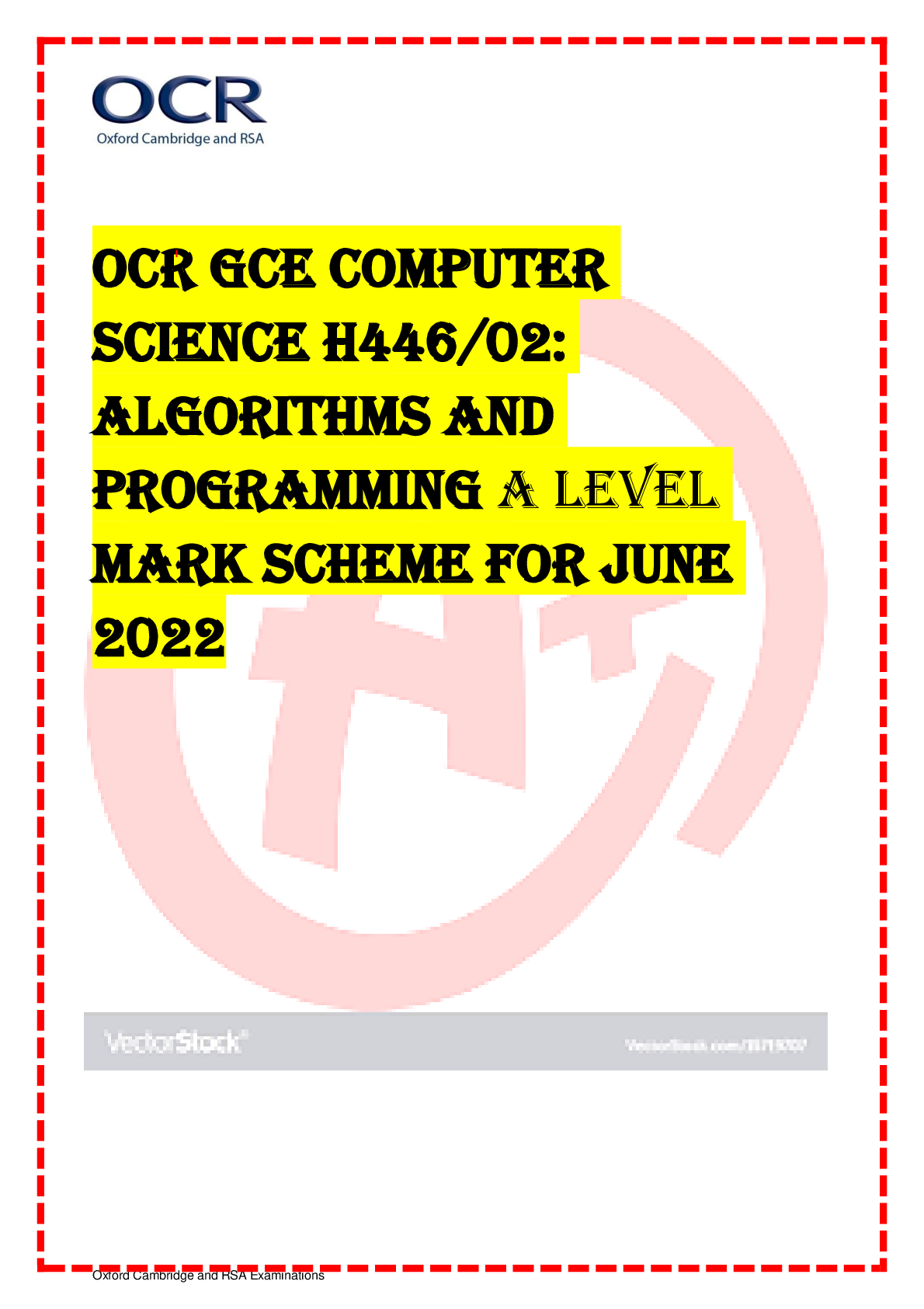Computer Science > AS Mark Scheme > GCE Computer Science H446/02: Algorithms and programming Advanced GCE Mark Scheme for Autumn 2021 (All)
GCE Computer Science H446/02: Algorithms and programming Advanced GCE Mark Scheme for Autumn 2021
Document Content and Description Below
Oxford Cambridge and RSA Examinations GCE Computer Science H446/02: Algorithms and programming Advanced GCE Mark Scheme for Autumn 2021Oxford Cambridge and RSA Examinations OCR (Oxford Cambridge... and RSA) is a leading UK awarding body, providing a wide range of qualifications to meet the needs of candidates of all ages and abilities. OCR qualifications include AS/A Levels, Diplomas, GCSEs, Cambridge Nationals, Cambridge Technicals, Functional Skills, Key Skills, Entry Level qualifications, NVQs and vocational qualifications in areas such as IT, business, languages, teaching/training, administration and secretarial skills. It is also responsible for developing new specifications to meet national requirements and the needs of students and teachers. OCR is a not-for-profit organisation; any surplus made is invested back into the establishment to help towards the development of qualifications and support, which keep pace with the changing needs of today’s society. This mark scheme is published as an aid to teachers and students, to indicate the requirements of the examination. It shows the basis on which marks were awarded by examiners. It does not indicate the details of the discussions which took place at an examiners’ meeting before marking commenced. All examiners are instructed that alternative correct answers and unexpected approaches in candidates’ scripts must be given marks that fairly reflect the relevant knowledge and skills demonstrated. Mark schemes should be read in conjunction with the published question papers and the report on the examination. © OCR 20211. Annotations Annotation Meaning Omission mark Benefit of the doubt Incorrect point Follow through Not answered question No benefit of doubt given Repeat Correct point Too vague Level 1 Level 2 Level 32 2. Subject-specific Marking Instructions INTRODUCTION Your first task as an Examiner is to become thoroughly familiar with the material on which the examination depends. This material includes: • the specification, especially the assessment objectives • the question paper and its rubrics • the mark scheme. You should ensure that you have copies of these materials. You should ensure also that you are familiar with the administrative procedures related to the marking process. These are set out in the OCR booklet Instructions for Examiners. If you are examining for the first time, please read carefully Appendix 5 Introduction to Script Marking: Notes for New Examiners. Please ask for help or guidance whenever you need it. Your first point of contact is your Team Leader.USING THE MARK SCHEME Please study this Mark Scheme carefully. The Mark Scheme is an integral part of the process that begins with the setting of the question paper and ends with the awarding of grades. Question papers and Mark Schemes are developed in association with each other so that issues of differentiation and positive achievement can be addressed from the very start. This Mark Scheme is a working document; it is not exhaustive; it does not provide ‘correct’ answers. The Mark Scheme can only provide ‘best guesses’ about how the question will work out, and it is subject to revision after we have looked at a wide range of scripts. The Examiners’ Standardisation Meeting will ensure that the Mark Scheme covers the range of candidates’ responses to the questions, and that all Examiners understand and apply the Mark Scheme in the same way. The Mark Scheme will be discussed and amended at the meeting, and administrative procedures will be confirmed. Co-ordination scripts will be issued at the meeting to exemplify aspects of candidates’ responses and achievements; the co-ordination scripts then become part of this Mark Scheme. Before the Standardisation Meeting, you should read and mark in pencil a number of scripts, in order to gain an impression of the range of responses and achievement that may be expected. In your marking, you will encounter valid responses which are not covered by the Mark Scheme: these responses must be credited. You will encounter answers which fall outside the ‘target range’ of Bands for the paper which you are marking. Please mark these answers according to the marking criteria. Please read carefully all the scripts in your allocation and make every effort to look positively for achievement throughout the ability range. Always be prepared to use the full range of marks.4 LEVELS OF RESPONSE QUESTIONS: The indicative content indicates the expected parameters for candidates’ answers, but be prepared to recognise and credit unexpected approaches where they show relevance. Using ‘best-fit’, decide first which set of BAND DESCRIPTORS best describes the overall quality of the answer. Once the band is located, adjust the mark concentrating on features of the answer which make it stronger or weaker following the guidelines for refinement. • Highest mark: If clear evidence of all the qualities in the band descriptors is shown, the HIGHEST Mark should be awarded. • Lowest mark: If the answer shows the candidate to be borderline (i.e. they have achieved all the qualities of the bands below and show limited evidence of meeting the criteria of the band in question) the LOWEST mark should be awarded. • Middle mark: This mark should be used for candidates who are secure in the band. They are not ‘borderline’ but they have only achieved some of the qualities in the band descriptors. Be prepared to use the full range of marks. Do not reserve (e.g.) high Band 3 marks ‘in case’ something turns up of a quality you have not yet seen. If an answer gives clear evidence of the qualities described in the band descriptors, reward appropriately.AO1 AO2 AO3 High (thorough) Precision in the use of question terminology. Knowledge shown is consistent and well-developed. Clear appreciation of the question from a range of different perspectives making extensive use of acquired knowledge and understanding. Knowledge and understanding shown is consistently applied to context enabling a logical and sustained argument to develop. Examples used enhance rather than detract from response. Concerted effort is made to consider all aspects of a system / problem or weigh up both sides to an argument before forming an overall conclusion. Judgements made are based on appropriate and concise arguments that have been developed in response resulting in them being both supported and realistic. Middle (reasonable) Awareness of the meaning of the terms in the question. Knowledge is sound and effectively demonstrated. Demands of question understood although at times opportunities to make use of acquired knowledge and understanding not always taken. Knowledge and understanding applied to context. Whilst clear evidence that an argument builds and develops through response there are times when opportunities are missed to use an example or relate an aspect of knowledge or understanding to the context provided. There is a reasonable attempt to reach a conclusion considering aspects of a system / problem or weighing up both sides of an argument. However the impact of the conclusion is often lessened by a lack of supported judgements which accompany it. This inability to build on and develop lines of argument as developed in the response can detract from the overall quality of the response. Low (basic) Confusion and inability to deconstruct terminology as used in the question. Knowledge partial and superficial. Focus on question narrow and often one-dimensional. Inability to apply knowledge and understanding in any sustained way to context resulting in tenuous and unsupported statements being made. Examples if used are for the most part irrelevant and unsubstantiated. Little or no attempt to prioritise or weigh up factors during course of answer. Conclusion is often dislocated from response and any judgements lack substance due in part to the basic level of argument that has been demonstrated throughout response.6 Assessment Objective AO1 Demonstrate knowledge and understanding of the principles and concepts of computer science, including abstraction, logic, algorithms and data representation. AO1.1 Demonstrate knowledge of the principles and concepts of abstraction, logic, algorithms, data representation or other as appropriate. AO1.2 Demonstrate understanding of the principles and concepts of abstraction, logic, algorithms, data representation or other as appropriate. AO2 Apply knowledge and understanding of the principles and concepts of computer science including to analyse problems in computational terms. AO2.1 Apply knowledge and understanding of the principles and concepts of computer science. AO2.2 Analyse problems in computational terms. AO3 Design, program and evaluate computer systems that solve problems, making reasoned judgements about these and presenting conclusions. AO3.1 Design computer systems that solve problems. AO3.2 Program computer systems that solve problems. AO3.3 Evaluate computer systems that solve problems, making reasoned judgements about these and presenting conclusions.Question Answer Marks Guidance 1a 1 mark per bullet to max 3. e.g. • Remove unnecessary details // remove character features that are not needed • e.g. remove the outside world • e.g. Remove complexity from the realistic entities // Simply real-life objects • e.g. simplify characters/animals/tents • e.g. by representing them with specific objects/shapes 3 AO2.1 (2) AO2.2 (1) 1bi 1 mark per bullet to max 2 e.g. • Multiple processes being executed at the same time // appearing to happen simultaneously • Giving processes a slice of the processor time • Having multiple processors each carrying out a different process 2 AO1.1 (2) 1bii 1 mark per bullet to max 3 e.g: • Game could have large number of requests to the server at a time • … server needs to respond in reasonable time • … having multiple processors handling the different requests would increase response time • Users could override each other’s changes • … e.g. needs to handle if someone updates their circus while someone else is visiting • …use record locking to stop edits if someone else has access to data • Different users will have different response times • …therefore the processor can still handle other requests • …so that the performance for other users is not affected 3 AO2.1 (2) AO2.2 (1) 1ci 1 mark per bullet to max 2 e.g: • A rule of thumb / estimate / guess • That estimates the distance / cost from each node to the destination node • To speed up the process of finding a solution • …by identify which paths to follow first 2 AO1.1 (1) AO1.2 (1)8 1cii Node Distance travelled Heuristic Distance travelled + Heuristic Previous node MARKING GUIDANCE A (✓) 0 90 90 1 MARK B (✓) ∞ 21 80 101 A 1 MARK C (✓) ∞ 42 65 107 A 1 MARK D (✓) ∞ 21+38=59 42+12=54 50 109 104 B C 1 MARK E ∞ 21+40=61 50 111 B 1 MARK F (✓) ∞ 42+12+23=77 30 107 D 1 MARK G ∞ 42+12+23+33=110 0 110 F 1 MARK Final path = A,C,D,F,G and Distance = 110 (1 Mark) 8 AO1.2 (3) AO2.1 (3) AO2.2 (2) 1d 1 mark per bullet to max 6 • Visit root node M • Visit E and S • Visit C and J (from E) • …then P and V (from S) • Visit G and K (from J) • Visit L (from K) 6 AO1.2 (1) AO2.1 (3) AO2.2 (2)1e Mark Band 3 – High level (7-9 marks) The candidate demonstrates a thorough knowledge and understanding of data mining; the material is generally accurate and detailed. The candidate is able to apply their knowledge and understanding directly and consistently to the context provided. Evidence/examples will be explicitly relevant to the explanation. The candidate is able to weigh up the use of data mining which results in a supported and realistic judgment as to whether it is possible to use them in this context. There is a well-developed line of reasoning which is clear and logically structured. The information presented is relevant and substantiated. Mark Band 2 – Mid level (4-6 marks) The candidate demonstrates reasonable knowledge and understanding of data mining; the material is generally accurate but at times underdeveloped. The candidate is able to apply their knowledge and understanding directly to the context provided although one or two opportunities are missed. Evidence/examples are for the most part implicitly relevant to the explanation. The candidate makes a reasonable attempt to come to a conclusion showing some recognition of influencing factors that would determine whether it is possible to use data mining in this context. There is a line of reasoning presented with some structure. The information presented is in the most part relevant and supported by some evidence Mark Band 1 – Low Level (1-3 marks) The candidate demonstrates a basic knowledge of data mining with limited understanding shown; the material is basic and contains some inaccuracies. The candidates makes a limited attempt to apply acquired knowledge and understanding to the context provided. The candidate provides nothing more than an unsupported assertion. The information is basic and comunicated in an unstructured way. The information is supported by limited evidence and the relationship to the evidence may not be clear. 0 marks No attempt to answer the question or response is not worthy of credit. 9 AO1.1 (2) AO1.2 (2) AO2.1 (2) AO3.3 (3) AO1: Knowledge and Understanding Indicative content • Data mining searches large amounts of data • Searches for relationships between facts/components/events that may not be obvious • May include pattern matching algorithms • May involve anomaly detection algorithms • Used for business modelling • Used to plan for future eventualities AO2: Application • Can look for how people use the website e.g. visiting times, what they click on, how long they spend on certain features, what they do first, which elements are used least • Give recommendations for future changes to the game e.g. features to add, or remove AO3: Evaluation Candidates will need to evaluate the benefits and drawbacks of using data mining. e.g. • Can use to introduce new features • Increase use from users • Increase revenue by selling features used more often • Make the game more appealing • Remove features people don’t use • Use to target advertising • Privacy concerns from users • Misuse of information10 2ai 1 mark for each number/statement up to a maximum of 6 marks: function binarySearch(dataArray:byref, upperbound, lowerbound, searchValue) while true middle = lowerbound + ((upperbound - lowerbound) DIV 2) if upperbound < lowerbound then return -1 else if dataArray[middle] < searchValue then lowerbound = middle + 1 elseif dataArray[middle] > searchValue then upperbound = middle - 1 else return middle endif endif endwhile endfunction 6 AO1.2 (2) AO3.3 (4) 2aii Do…until // repeat…until // post condition 1 AO1.2 (1)2b 1 mark for each tick up to a maximum of 6 marks Worst-case space complexity: Binary search Linear search O(log(n)) O(1) O(n) Best-case space complexity: Binary search Linear search O(log(n)) O(1) O(n) Average time complexity: Binary search Linear search O(log(n)) O(1) O(n) 6 AO1.1 (6) 2c 1 mark for any example e.g. • Data is not sorted • Item you are looking for is the first item in the list • Small number of items 1 AO1.2 (1)12 3a 1 mark per bullet, each must be applied correctly to data • Choose a pivot // identify start and end pointers • Compare each element to the pivot… // compare start and end pointers • Put items < pivot in the left sublist • Put items > pivot in the right sublist • Choose a pivot in each sublist • If start pointer is larger than end pointer… • …then swap data items around • And repeat the process until each item becomes a pivot 5 AO1.2 (2) AO2.2 (3) 3b 1 mark per bullet to max 2 • decomposing data sets into smaller subsets • and then sorting each split subset • until each subset is sorted • and then combining the subsets to provide a solution 2 AO1.1 (1) AO2.1 (1)4 Mark Band 3 – High level (7-9 marks) The candidate demonstrates a thorough knowledge and understanding of IDEs; the material is generally accurate and detailed. The candidate is able to apply their knowledge and understanding directly and consistently to the context provided. Evidence/examples will be explicitly relevant to the explanation. The candidate is able to weigh up the use of IDEs which results in a supported and realistic judgment as to whether it is possible to use them in this context. There is a well-developed line of reasoning which is clear and logically structured. The information presented is relevant and substantiated. Mark Band 2 – Mid level (4-6 marks) The candidate demonstrates reasonable knowledge and understanding of IDEs; the material is generally accurate but at times underdeveloped. The candidate is able to apply their knowledge and understanding directly to the context provided although one or two opportunities are missed. Evidence/examples are for the most part implicitly relevant to the explanation. The candidate makes a reasonable attempt to come to a conclusion showing some recognition of influencing factors that would determine whether it is possible to use IDEs in this context. There is a line of reasoning presented with some structure. The information presented is in the most part relevant and supported by some evidence Mark Band 1 – Low Level (1-3 marks) The candidate demonstrates a basic knowledge of IDEs with limited understanding shown; the material is basic and contains some inaccuracies. The candidates makes a limited attempt to apply acquired knowledge and understanding to the context provided. The candidate provides nothing more than an unsupported assertion. The information is basic and comunicated in an unstructured way. The information is supported by limited evidence and the relationship to the evidence may not be clear. 0 marks No attempt to answer the question or response is not worthy of credit. 9 AO1.1 (2) AO1.2 (2) AO2.1 (2) AO3.3 (3) AO1: Knowledge and Understanding Indicative content e.g. • IDE is software that includes an editor, compiler, run-time environment Creating • Autocorrect • Autocomplete • Pretty printing Testing • Breakpoints • Stepping • Variable watch window AO2: Application e.g. • Tell you when you make a syntax error • Allows you to write and run the code in one piece of software • Suggests code so you don’t have to remember code, or autocorrect spelling mistakes • Helps you trace the program so you can see what happens when values change without having to manually insert print statements etc. • Autogenerate boilerplate code. AO3: Evaluation Candidates will need to evaluate the benefits and drawbacks of using IDEs. e.g. • Reduce errors through autocorrect and suggestions • Reduce time to write the program because features help you spot errors before running the code, some errors will be corrected so you don’t have to • Write and test in one environment so you don’t have to close and run elsewhere, then re-open etc.14 5a To create an instance of an object from a class 1 AO2.1 (1) 5b 1 mark per bullet up to a maximum of 2 marks, e.g: • When the child/derived/subclass class office/house takes on attributes/methods… • … from building / parent/base/superclass/ class 2 AO1.2 (1) AO2.2 (1) 5c 1 mark for each completed statement up to a maximum of 5 marks: class building private numberFloors private width private height public procedure new(pFloors, pWidth, pHeight) numberFloors = pFloors width = pWidth height = pHeight endprocedure public function getNumberFloors() return numberFloors endfunction public function setNumberFloors(pFloors) if pFloors >= 1 then numberFloors = pFloors return true else return false endif endfunction endclass 5 AO2.2 (3) AO3.2 (2) Accept other specific language conventions that would correctly achieve the same outcomes.5d 1 mark per bullet up to a maximum of 6 marks: • Class declaration for house with inherits building • Declaring bedrooms and bathrooms as private • New declaration … • … with all five parameters • Calling super constructor // equivalent with floors, width and height set • Setting bedrooms and bathrooms e.g. class house inherits building private bedrooms, bathrooms public procedure new(pFloors, pWidth, pHeight, pBedrooms, pBathrooms) super.new(pFloors, pWidth, pHeight) bedrooms = pBedrooms bathrooms = pBathrooms endprocedure endclass 6 AO2.1 (1) AO2.2 (2) AO3.2 (3) 5e 1 mark per bullet up to a maximum of 4 marks: • Procedure header taking parameter • Adding parameter to array • …at position numberBuildings • Incrementing numberBuilding e.g. procedure newbuilding(pBuilding) buildings[numberBuildings] = pBuilding numberBuildings = numberBuildings + 1 endprocedure 4 AO2.1 (1) AO3.2 (3)16 f 1 mark per bullet up to a maximum of 4 marks: • Creating a new instance of house with identifier houseOne • …with the correct parameters • Creating a new instance of houseRoad named limeAvenue • …sending houseOne as parameter to the constructor e.g. houseOne = new house(2, 8, 10, 3, 2) limeAvenue = new houseRoad(houseOne) 4 AO2.1 (1) AO3.2 (3) 6a 1 mark for each interval Interval 1 • A is fetched Interval 2 • A is decoded • B is fetched Interval 3 • A is executed • B is decoded • C is fetched Interval 4 • B is executed • C is decoded D is fetched 4 AO1.2 (4) 6b 1 mark per bullet up to a maximum of 2 marks: • Reduces/removes latency • … CPU is not idle while waiting for next instruction • Next instruction is fetched while current one is decoded/executed • All parts of the processor can be used at any instance in time. 2 AO1.2 (2)7a 1 mark for the purpose and 1 mark for matching appropriate name (4 marks total), e.g: • Pointer to the first element in the queue • firstElement // any other meaningful name • Pointer to the last element in the queue // Pointer to the first free element in the queue • lastElement / any other meaningful name 4 AO1.2 (4) Must cover purpose and name for 2 marks for each pointer. 7b 1 mark per bullet up to a maximum of 5 marks, e.g: • Check if the queue is full • … if the firstElement pointer (+1) = lastElement // length variable == queue’s capacity • … if it is return False • Adds element at lastElement (+1) position // Adds element at startposition+length • … increments lastElement pointer • If lastElement is greater than last Index // pointer becomes pointer MOD array.size • …reset to 0 5 AO1.2 (5) Look out for variations in representing the queue18 8ai 1 mark per box up to a maximum of 3 marks. • Select puzzle and display blank grid (below new game) • Select box and change colour of boxes (below play game) • Compare to answer and display correct/incorrect (below check answer) e.g. 3 AO2.2 (3) Boxes might be in 1 box, or split down into many. Positioning only needs to be below those identified. Ignore any additional/irrelevant boxes. 8aii 1 mark per bullet up to a maximum of 2 marks, e.g: e.g. • Splits the problem into smaller chunks • Smaller problems are more manageable • Smaller problems are easier to solve • To see where code can be reused in the solution • To split tasks between different programmers 2 AO1.1 (1) AO1.2 (1) Nonogram New Game Select Puzzle Display blank grid Play game Select Box Change colour of boxes Check answer Compare to answer Display Correct/Incorrect8aiii 1 mark for input, 1 for process 1 for output e.g. Input: • Clicking a box Process: • Generating new puzzle • Checking if block is black • Changing block to white Output: • Grid with coloured squares 3 AO2.2 (3)20 8bi 1 mark for each correctly completed statement up to a maximum of 5 marks: 01 function countRow(puzzle:byref, rowNum:byval) 02 count = 0 03 output = " " 04 for i = 0 To 4 05 if puzzle[rowNum, i] == 1 then 06 count = count + 1 07 elseif count >= 1 then 08 output = output + str(count) + " " 09 count = 0 10 endif 11 next i 12 if count>= 1 then 13 output=ouput+str(count) 14 elseif output == "" then 15 output = "0" 16 endif 17 return output 18 endfunction 5 AO2.2 (2) AO3.2 (3) Accept for i = 0 to row.length-1 for i = 0 to row.length for i=0 to 5 8bii 1 mark per bullet up to a maximum of 2 marks, e.g: • Initialise the variable output… • …with a space • …for use later on in the code… • …So it can be used for concatenation later in the code … • …to avoid an error being generated 2 AO1.2 (1) AO2.2 (1) 8biii 1 mark per bullet up to a maximum of 3 marks, e.g: • check the value stored in each index • check whether it is at the end of a row • check whether each row has been given an output or not 3 AO2.2 (3)8biv 1 mark per bullet up to a maximum of 6 marks: • Procedure heading for displayRowAnswer • …taking puzzle as parameters • Nested loops through all array elements • …outputting all rows • … at the end of each row calling countRow …. • …..with parameters puzzle and the current loop counter e.g. procedure displayRowAnswer(puzzle) for i = 0 To 4 for j = 0 To 4 print(puzzle[i, j] + " ") next j print (" " + countRow(puzzle, i)) next i endprocedure 6 AO2.2 (3) AO3.2 (3) Accept for i = 0 to row.length-1 for i = 0 to row.length for i=0 to 5 8bv 1 mark for clearly identifying each error and giving the correction. • Line 01 needs answerGrid as parameter • Line 04 == should be != • Line 08 should be next row 3 AO2.1 (3) Do not award marks for line numbers alone without stating the error. Consider 1 mark for not changing line 04 but changing 05 to true and 09 to False22 8c Mark Band 3 – High level (7-9 marks) The candidate demonstrates a thorough knowledge and understanding of local and global variables; the material is generally accurate and detailed. The candidate is able to apply their knowledge and understanding directly and consistently to the context provided. Evidence/examples will be explicitly relevant to the explanation. The candidate is able to weigh up the use of both local and global variables which results in a supported and realistic judgment as to whether it is possible to use them in this context. There is a well-developed line of reasoning which is clear and logically structured. The information presented is relevant and substantiated. Mark Band 2 – Mid level (4-6 marks) The candidate demonstrates reasonable knoledge and understanding of local and global variables; the material is generally accurate but at times underdeveloped. The candidate is able to apply their knowledge and understanding directly to the context provided although one or two opportunities are missed. Evidence/examples are for the most part implicitly relevant to the explanation. The candidate makes a reasonable attempt to come to a conclusion showing some recognition of influencing factors that would determine whether it is possible to use local and global variables in this context. There is a line of reasoning presented with some structure. The information presented is in the most part relevant and supported by some evidence Mark Band 1 – Low Level (1-3 marks) The candidate demonstrates a basic knowledge of local and global variables with limited understanding shown; the material is basic and contains some inaccuracies. The candidates makes a limited attempt to apply acquired knowledge and understanding to the context provided. The candidate provides nothing more than an unsupported assertion. The information is basic and comunicated in an unstructured way. The information is supported by limited evidence and the relationship to the evidence may not be clear. 0 marks No attempt to answer the question or response is not worthy of credit. 9 AO1.1 (2) AO1.2 (2) AO2.1 (2) AO3.3 (3) AO1: Knowledge and Understanding Indicative content Local variables: • Scope within the module defined within • Cannot access externally unless passed as parameter, or returned from function • When module is exited, memory of variable is freed Global variables: • Scope within the entire program • Can access from anywhere • Retained in memory permanently ByRef Points to location of variable ByVal Sends the value AO2: Application • If global the arrays can be accessed from all modules by direct reference • If local to the main, the arrays will need to be passed as parameters byreference • Can send ByVal – but not always possible with arrays in some languages • Modules are self contained and then can be reused in other programs he wants to create without needing to take the global variables with them AO3: Evaluation e.g. • +ve Local = memory efficient • +ve Global = easier programming, simpler to follow, easier to debug • -ve Global = memory inefficient, not good programming technique • -ve Local = more difficult to trace/debug/follow where the values are passed • Relatively small program – don’t know about overall plan for it, it might not be memory intensive, unlikely anyone else is going to access/amend e.g. use as a library – therefore global would not waste significant resources8d 1 mark per bullet to max 4 e.g. • Make use of random numbers • Generate an x/horizontal size for the grid • Generate a y/vertical size for the grid • Loop through each row/column • …generate a number between 0 and the number of rows/columns (depending on MP4 answer) • Loop through each box • …generate a 1 or 0 to store in it 4 AO2.1 (2) AO2.2 (2)OCR (Oxford Cambridge and RSA Examinations) The Triangle Building Shaftesbury Road Cambridge [Show More]
Last updated: 1 year ago
Preview 1 out of 26 pages
Instant download

Instant download
Reviews( 0 )
Document information
Connected school, study & course
About the document
Uploaded On
Oct 10, 2022
Number of pages
26
Written in
Additional information
This document has been written for:
Uploaded
Oct 10, 2022
Downloads
0
Views
77








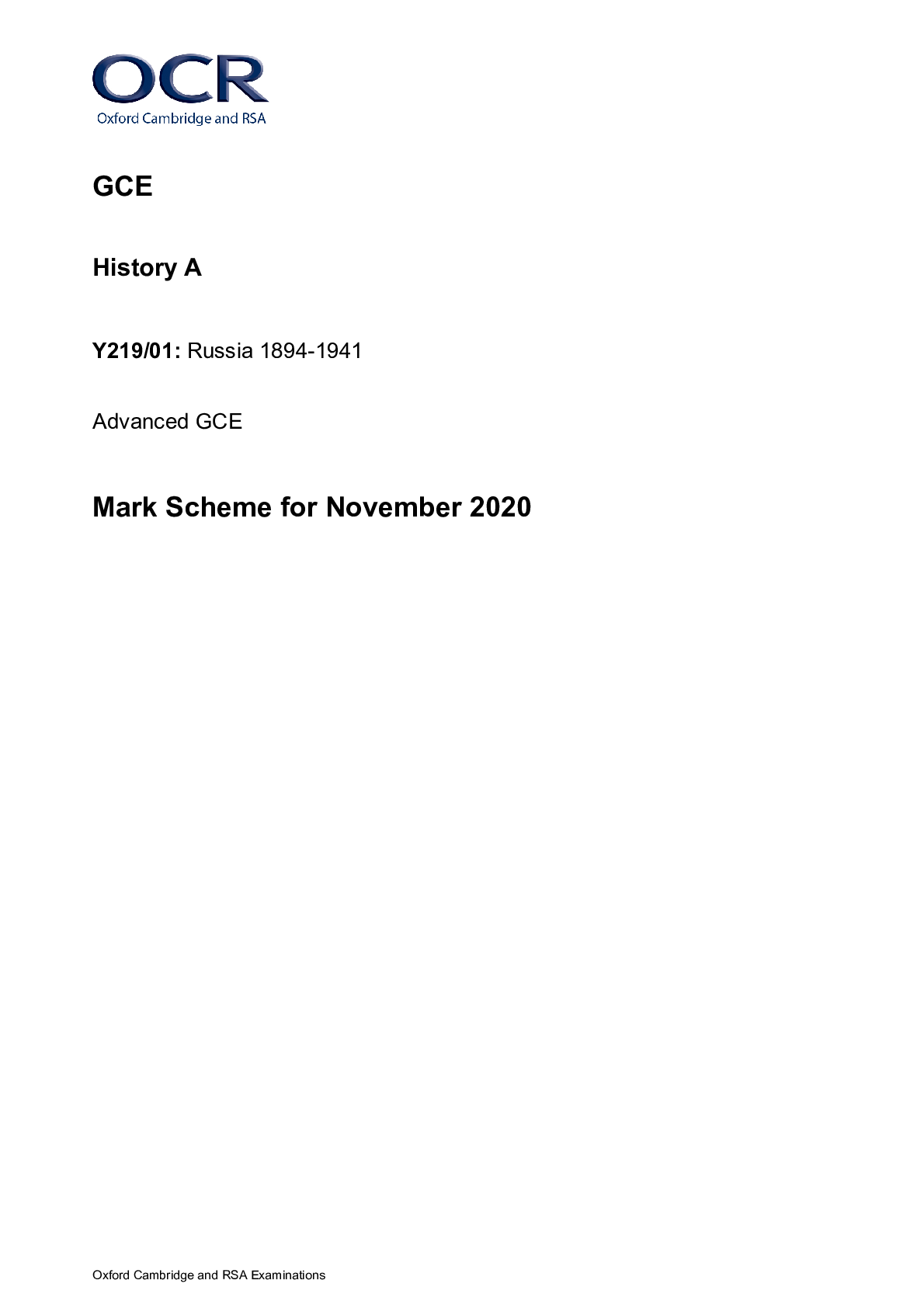
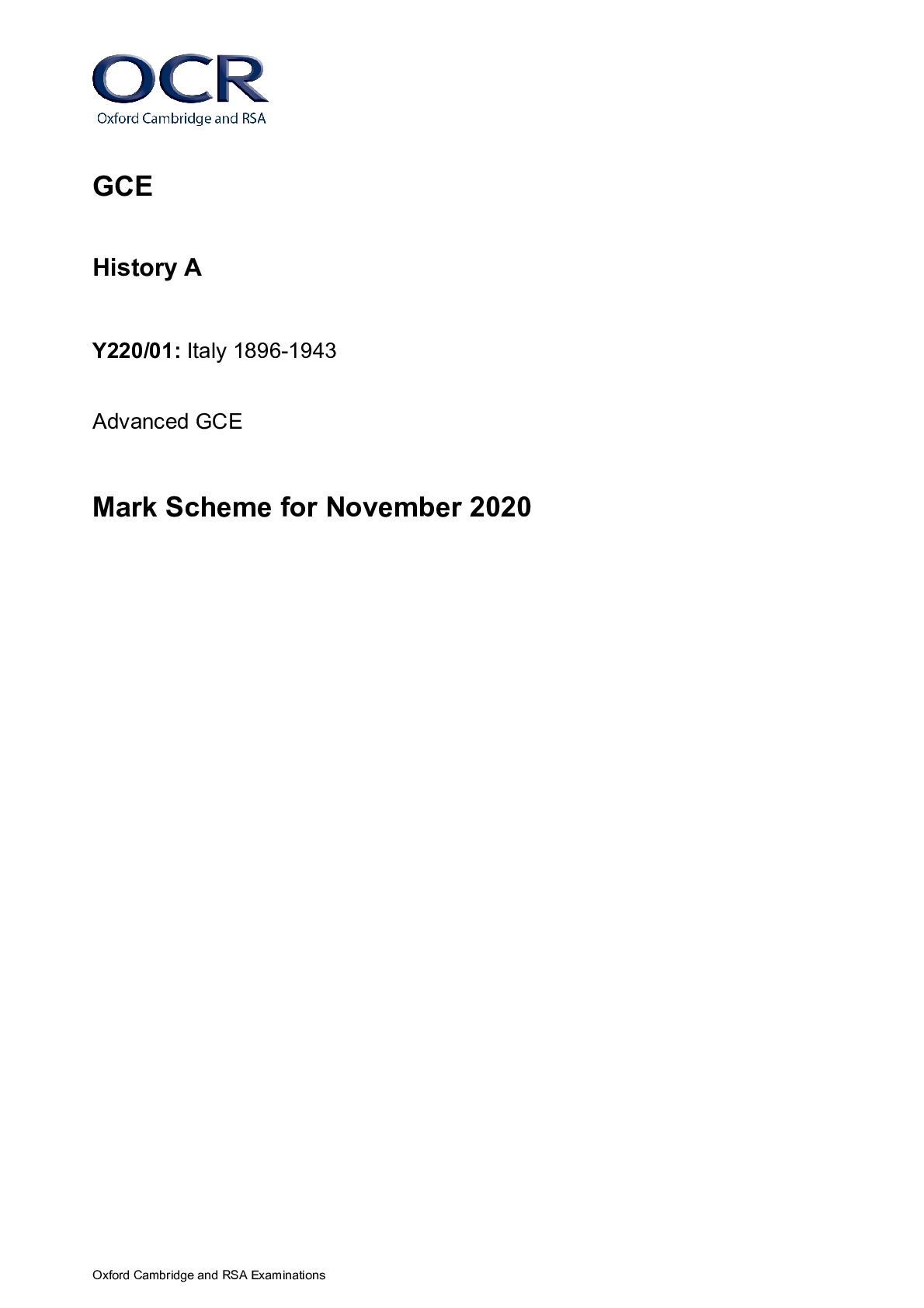

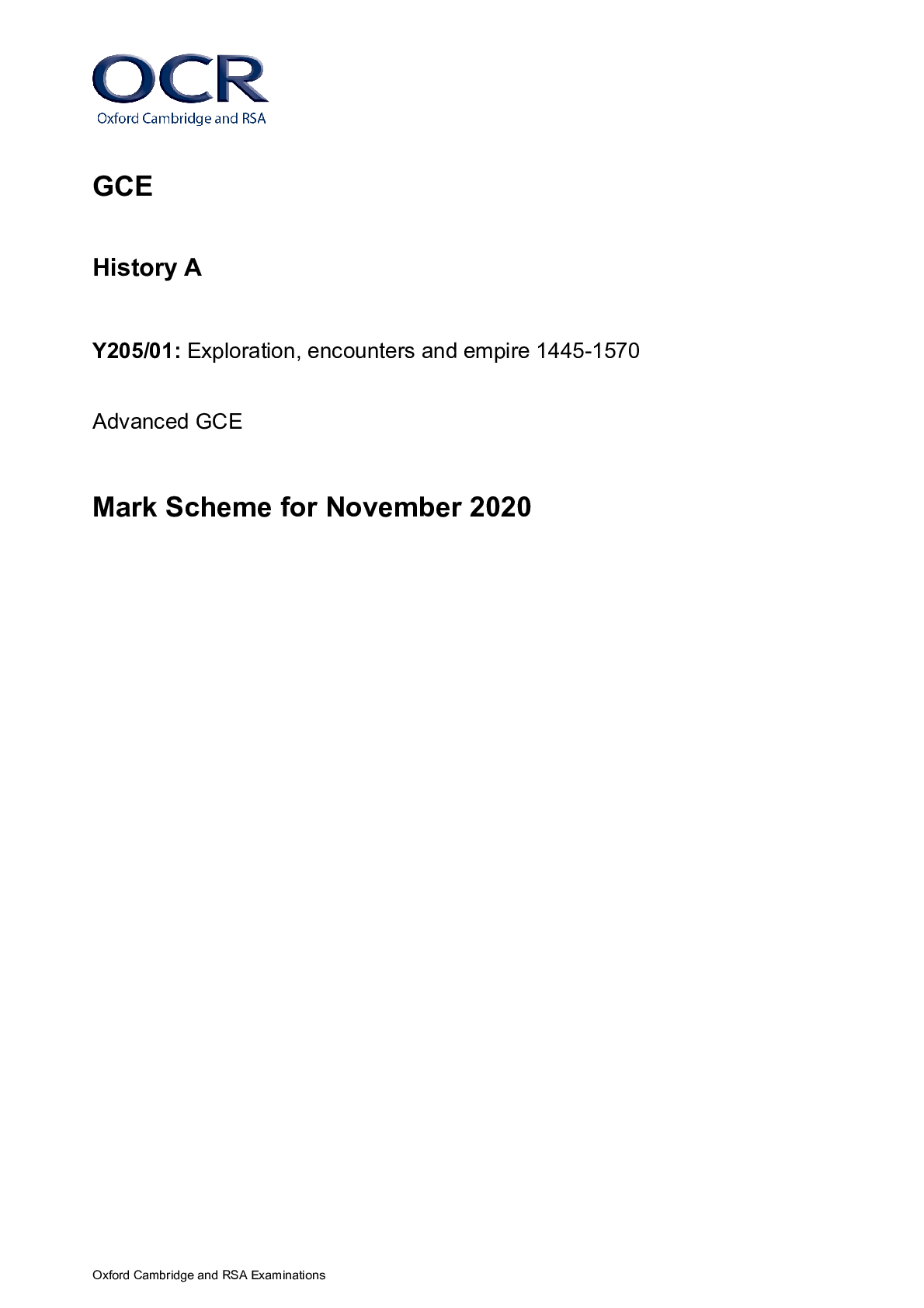
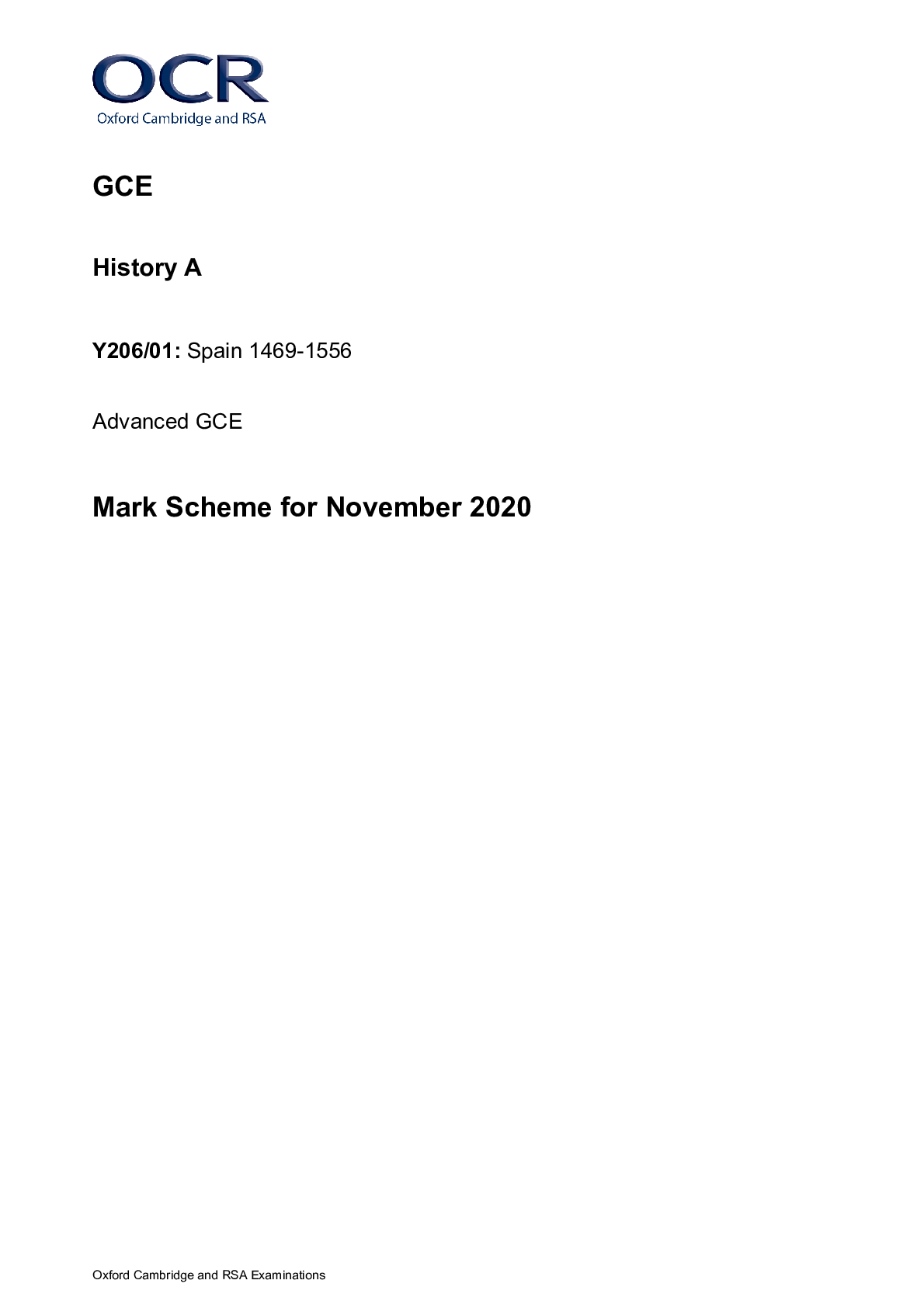
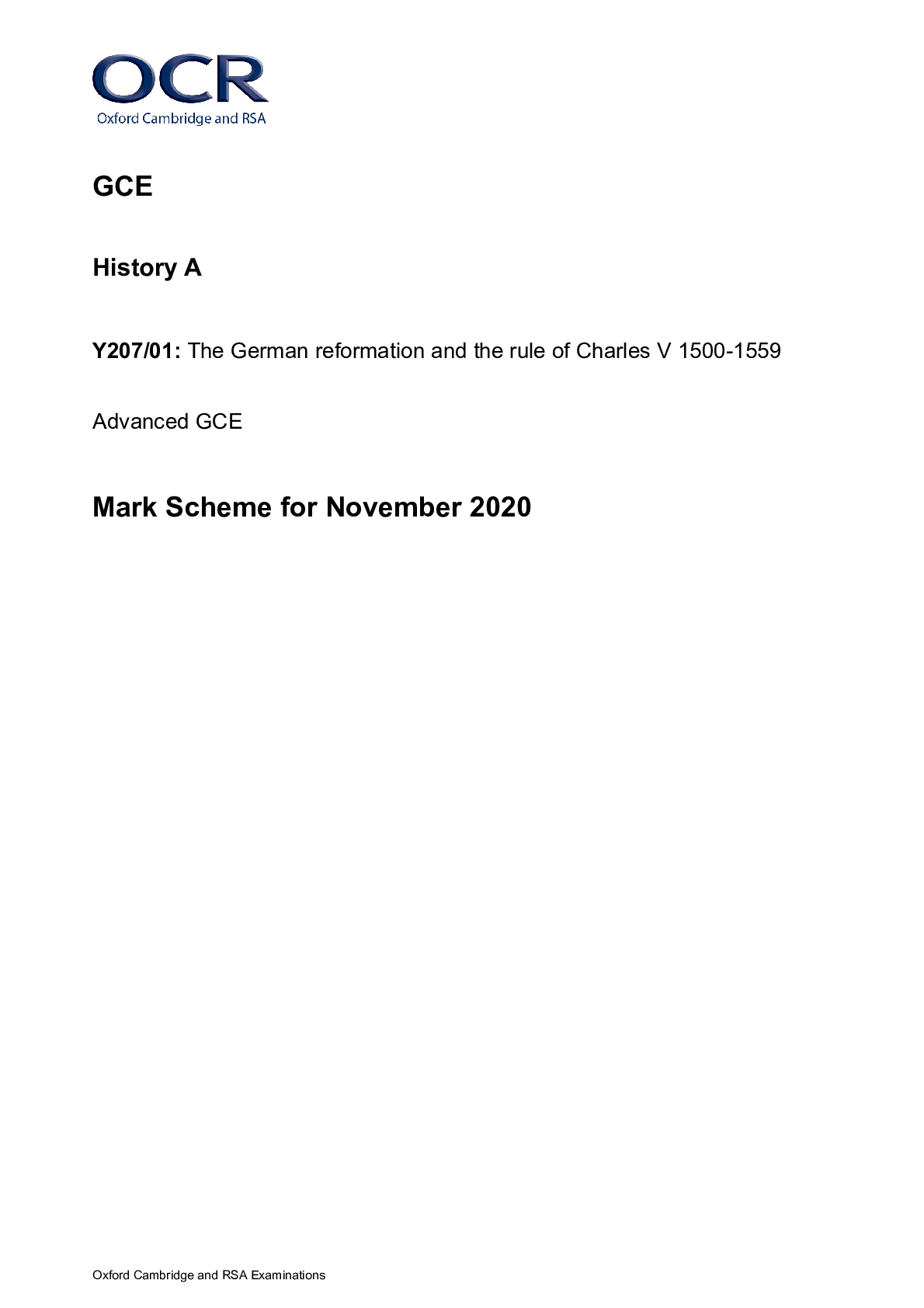
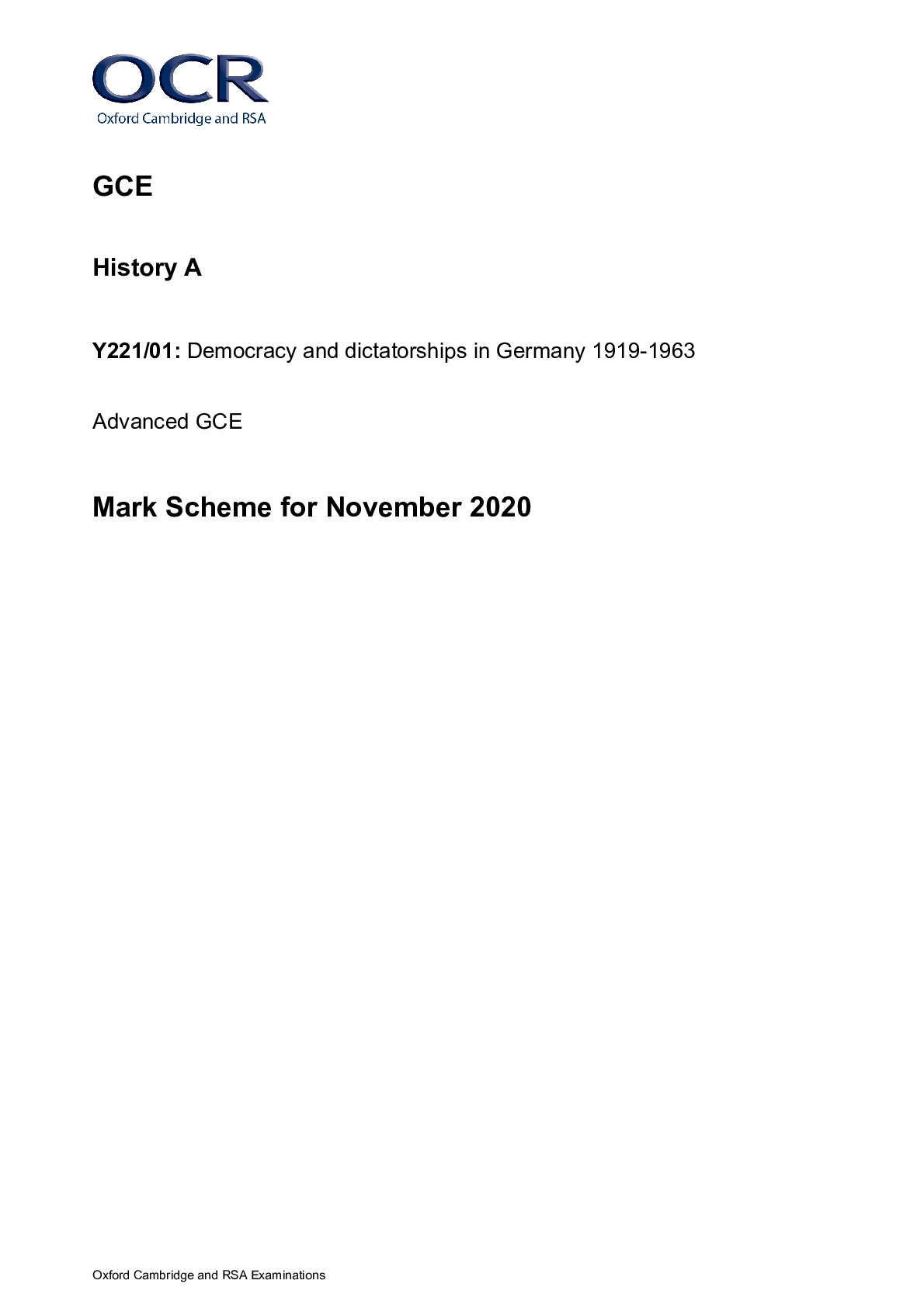

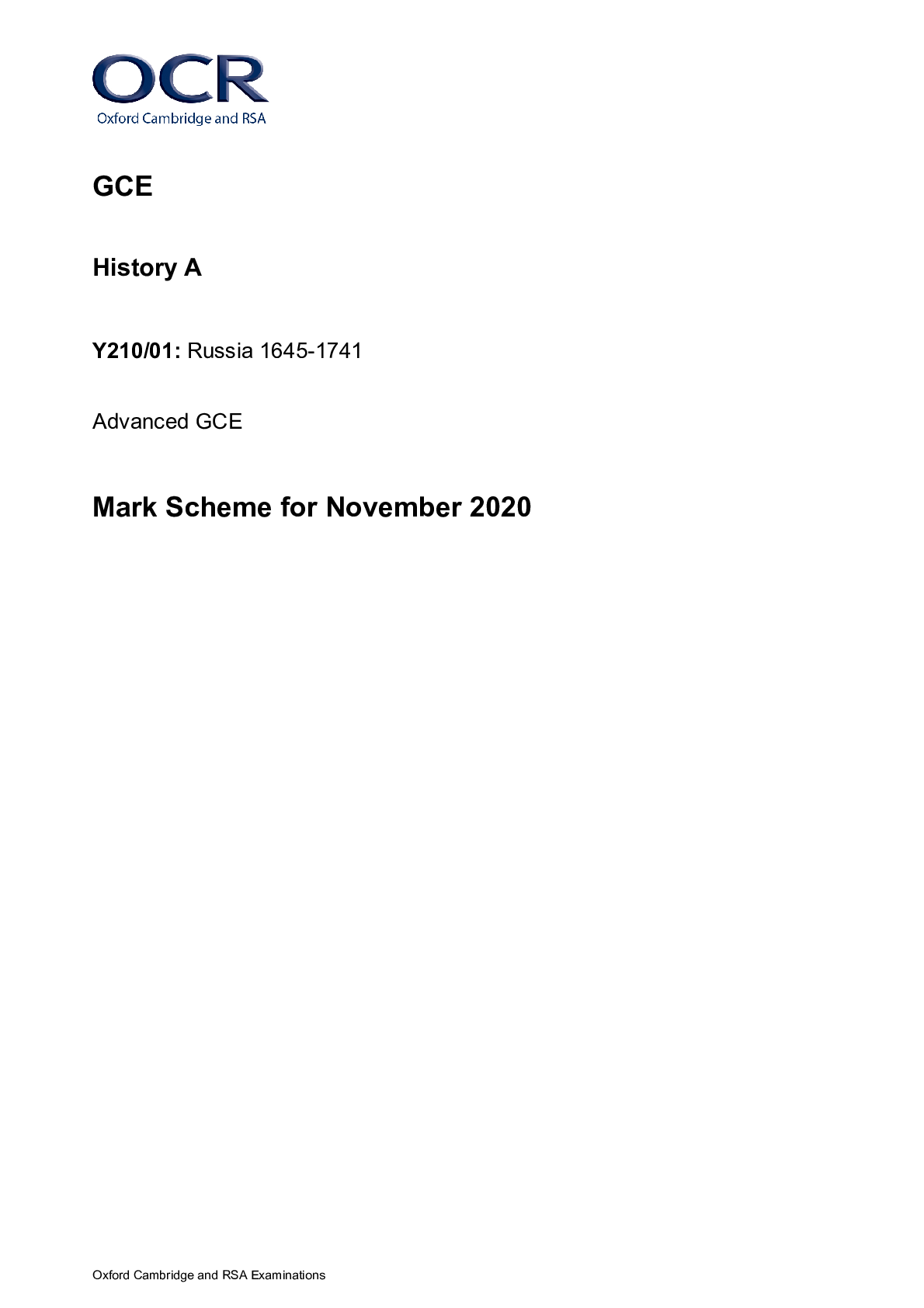


.png)



